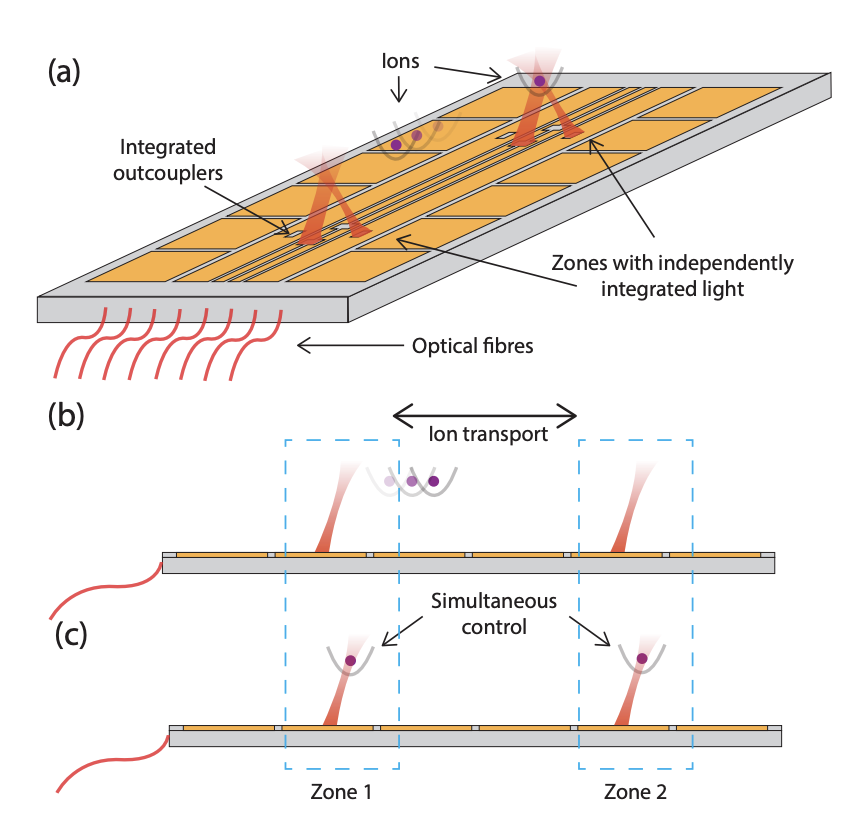Researchers from the Institute for Quantum Electronics and Quantum Center at ETH Zurich have made significant strides in developing a trapped-ion processor for large-scale architecture. The team used a surface electrode trap with integrated photonic components, scalable to larger numbers of zones, and implemented a Ramsey sequence using integrated light in two zones. They also developed techniques to measure and mitigate the effect of exposed dielectric surfaces. The research forms the primary components for a future scaled multizone trapped-ion QCCD device with integrated optical delivery.
Multizone Trapped Ion Qubit Control in Integrated Photonics QCCD Device
A team of researchers from the Institute for Quantum Electronics and Quantum Center at ETH Zurich, including Carmelo Mordini, Alfredo Ricci Vasquez, Yuto Motohashi, Mose Muller, Maciej Malinowski, Chi Zhang, Karan K Mehta, Daniel Kienzler, and Jonathan P Home, have demonstrated the fundamental building blocks for a trapped-ion processor in a large-scale architecture. They used a surface electrode trap with integrated photonic components, scalable to larger numbers of zones. The team implemented a Ramsey sequence using the integrated light in two zones separated by 375 µm, performing transport of the ion from one zone to the other in 200µs between pulses.
Techniques and Challenges
To achieve low motional excitation during transport, the team developed techniques to measure and mitigate the effect of the exposed dielectric surfaces used to deliver the integrated light to the ion. They also demonstrated simultaneous control of two ions in separate zones with low optical crosstalk and used this to perform simultaneous spectroscopy to correlate field noise between the two sites. The team faced challenges in delivering the laser light used to coherently control the qubits. The traditional approach based on free-space optics becomes challenging due to the combined constraints of creating multiple tightly focused beams and the presence of nearby trap electrodes.
Integrated Optics Light Delivery
The team used an alternative approach to deliver light using optical waveguides directly integrated into the trap structure, which provides compact routing of light to the zones of interest. Integrated optics light delivery has thus far primarily been implemented with ions in a single zone with ingredients including delivery of multiple wavelengths as well as all basic quantum operations including multi-ion quantum logic.
Multizone Trap and Transport Protocols
The team’s ion trap is a cryogenic segmented surface electrode trap with integrated photonics used to directly deliver light to calcium ions, which can be trapped in multiple zones of the chip. A key element of the work, both for loading and multizone operation, is the development and calibration of transport routines that accommodate for differences between the experimentally electric field landscape compared to their trap models, primarily due to the presence of the dielectric windows through which light is delivered.
Conclusion and Future Work
The team’s work demonstrates the first transport and coherent multizone operations in integrated photonic ion trap systems, forming the basis for further scaling in the trapped-ion QCCD architecture. The paper discusses two technical topics that enabled the experiments described above: independent control of the trap electric fields over multiple zones and their scheme for scalably delivering light to the different zones of the trap. This research forms the primary components for a future scaled multizone trapped-ion QCCD device with integrated optical delivery.
The article titled “Multi-zone trapped-ion qubit control in an integrated photonics QCCD device” was published on January 31, 2024. The authors of the article are Carmelo Mordini, Alfredo Ricci Vasquez, Yuto Motohashi, M. Müller, Maciej Malinowski, Chi Zhang, Karan K. Mehta, Daniel Kienzler, and Jonathan Home. The article was sourced from arXiv, a repository of electronic preprints approved for publication after moderation, hosted by Cornell University. The article can be accessed through its DOI reference https://doi.org/10.48550/arxiv.2401.18056.

